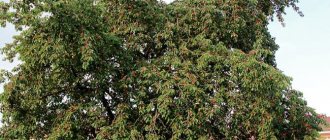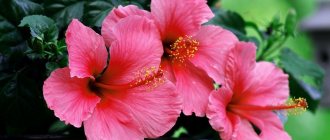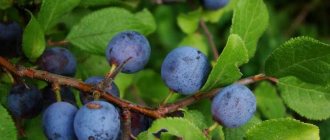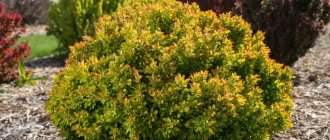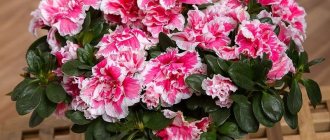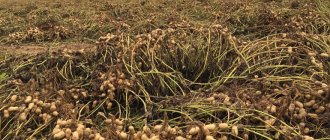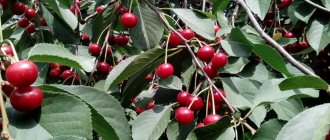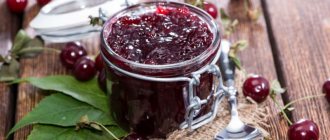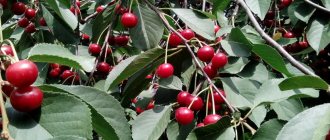Felt cherry is a plant of the plum genus. Its berries are small in size, but have a sweet dessert taste. They ripen earlier than the fruits of ordinary cherries, are eaten fresh, and are used for preservation. Felt cherry is a shrub from the Plum genus. Her homeland is China, Mongolia, Kyrgyzstan. The plant came to Russia from central China and is still called Chinese cherry. Since the mid-20th century, it has been grown in Europe and North America. The fruits of the tree ripen 2–3 weeks earlier than those of its “bigger” brother. The height of the bushes is small, so harvesting is easy. The berries of felt cherries are sweeter than usual, the characteristic sourness and astringency are absent. The plant belongs to plums, so it can cross with apricots, peaches, and cherries. Cherry has become the ancestor of many interesting hybrids.
Felt cherry: description
This is a shrub with a height not exceeding 1.5–2, less often 3 m. The crown is very thick and needs thinning. The bark on old branches is grayish-brown and thick. The leaves are small, slightly rough, and retain a delicate green color until September.
The cherry got its name - felted or downy - for a specific feature: the leaves, stalks, shoots, and berries are covered with a delicate soft fluff.
By May 15, the cherry blossoms begin to bloom. The flowers are white or light pink. They sit on such short stalks that they seem to grow straight from the branch. The color is abundant, the bush appears white.
The fruits appear by early June-July. The bone berry is smaller in size than a regular one - with a diameter of no more than 0.8–1.5 cm. The taste is sweet, delicate, without sourness. Usually the fruits are red, but there are varieties where cherries produce pinkish, white and black berries. The felt cherry variety produces its first harvest already in the 2nd year of life and bears fruit for 8–9 years. Up to 15 kg is removed from 1 tree.
Reviews indicate that the only drawback of Chinese cherries is their short lifespan. She lives from 10 to 18 years.
Decorative
Cherries are placed in a separate category, which not only produce delicious fruits, but also become the main decoration of the garden. The most popular variety is Zhelezistaya. The tree grows in Northern China, Japan, Korea, and nature reserves. The ornamental shrub has compact dimensions and a rounded shape, with flexible shoots and graceful green foliage. The main advantage of the variety is its very beautiful flowering with densely double snow-white flowers.
Ferruginous cherry blossoms throughout May and becomes the main decoration of the garden. The Bessey cherry variety is also classified as decorative.
The shoots are flexible, smooth, red-brown in color, and quite thin. The leaves are oblong green. The culture develops best in well-lit areas. It needs moderate watering, the soil is neutral, sandy loam, nutritious loam. The tree looks very beautiful together with coniferous trees, and is used for landscaping not only private properties, but also the territories of cottage villages.
Varieties of felt cherry
Many varieties of the plant have been developed. They differ in yield, berry color, and disease resistance. There is no particular difference in the taste of the fruits. The description of the felt cherry variety includes data on the industrial characteristics of the plant, the timing of flowering and ripening, the external characteristics of the tree and its fruits.
Natalie
Durable variety - lives up to 18 years. It tolerates frosts well, loves light, and easily withstands drought, but is sensitive to excess water: the risk of moniliosis increases. The variety is insensitive to coccomycosis and, to some extent, to clusterosporiosis.
The shrub is low, of medium density. The bark is gray and slightly flaky. The leaves are corrugated, with a strong felt fluff. It blooms from May 15 with pale pink or white flowers typical of the culture.
The berries ripen in 3–4 weeks. The cherries are round, with a slightly beveled tip, and dark red in color. The pulp is sweet and sour, juicy, but dense. The berries ripen at the same time, so the harvest should be harvested quickly.
Consumed raw or cooked. The variety is not suitable for transportation. Mechanized harvesting is also impossible, so Natalie is grown only in private gardens.
Princess
Low-growing shrub - no more than 1.2 m high, medium-branched. Lives a little less than 17 years, is not afraid of coccomycosis. It tolerates drought and cold easily, but is sensitive to waterlogging. It does not grow in lowlands.
Cherry blossoms bloom in May, the flowers are white and medium in size. But it produces large berries - up to 4 g in weight, red-pink, somewhat elongated in shape. The taste is remarkably sweet, the flesh is juicy and fibrous, the skin is shiny, and the edge is inconspicuous.
The Princess is grown in private gardens, since it is not suitable for transportation and mechanized harvesting.
The bush should be pruned periodically. When overloaded, the berries become very small.
Alice
Medium-sized bush - up to 1.5 m, cold-resistant, lives up to 17 years. It is not resistant to waterlogging - it is affected by moniliosis, but at the same time it is moderately resistant to drought. Cherries need to be watered during drought, but do not allow water to stagnate in the soil.
Description of the felt cherry variety: the crown of the bush is oval, dense, the foliage is dark green. Alice is grown to create a decorative fence. It blooms later - in the 3rd decade of May.
The berries are unusual: dark burgundy in color and have a pronounced oval shape with a clear “beak”. The taste is sweet and sour, the berries are juicy. Cherries are eaten fresh and used in the preparation of compotes, jelly, and jam. Not suitable for industrial breeding.
Summer
Self-fertile low bush, up to 1.5 m high. Almost resistant to pocket disease and not affected by moniliosis. Tolerates some lack of moisture. The plant withstands winter cold well; spring freezing does not threaten the buds. Disadvantage: Summer is defenseless against the codling moth.
The shrub is compact, not spreading. The first 2 years there is almost no growth. Shoots, leaves, berries are heavily pubescent. It blooms late - from the end of May to June 10. The flowers are large, white, flowering is not abundant.
This variety of felt cherry has unattractive berries: unevenly colored, irregular in shape with a “beak”. The pulp is sweet, but somewhat bland and juicy. The cherries remain on the branches for a month after ripening. The berries are being transported. Mechanical cleaning is allowed.
Summer is the genetic ancestor of many varieties of Chinese cherries.
Morning
A newly developed variety of felt cherry. Winter-hardy, drought-resistant, medium-yielding. Advantage: resistance to pests, including plum moth.
The shrub is low, with a sparse crown: it is easier to care for. The leaves are regular in shape and small. The pubescence of both leaves and berries is weak. It blooms with small white flowers in mid-May.
The berries of the felt cherry variety are small and juicy. The shape is rounded-angular. They cannot be transported.
Fairy tale
One of the most productive varieties: from 1 tree you can get up to 10–12 kg. The fairy tale can withstand both cold and heat, does not like excess moisture, but is rarely affected by moniliosis.
The height of the oval bush is only 1.3 m. It blooms in mid-May, very profusely. The berries ripen quickly and do not fall off. The berries are pleasant to the taste, large - up to 3.5 g, oval, elongated in shape. The peel is dark burgundy, the flesh is red.
Delight
Winter-hardy, early-fruiting, productive variety. Up to 9.5 kg is removed from the tree. Delight tolerates drought easily, but is sensitive to waterlogging. The culture reproduces well from cuttings.
The shrub grows no more than 1.5 in height. The crown is dense, thinning must be done every year. The leaves are oval, small, heavily pubescent. Blooms with five-petalled white flowers from May 10 to May 20.
The berries ripen simultaneously by July 10–20, which makes picking difficult. The fruits are oval, large - up to 3.5 g, bright red, shiny. Sweet and sour in taste, they take 4th place on the tasting scale.
Okeanskaya Virovskaya
Easily tolerates severe cold and drought, but is sensitive to waterlogging. It is not suitable for mechanized harvesting, so it is grown on private farms.
The plant is vigorous - at least 1.8 m. Lifespan - 17 years. The foliage is dark green, pubescent. The plant blooms late - from May 15 to May 25. The flowers are light pink and small.
The fruits are very impressive: regular oval in shape, dark burgundy in color, slightly pubescent. The red cartilaginous pulp is sweet, with a delicate sourness. On the taster scale it is rated 4 points. The berries ripen late - by July 20. Seedlings bear fruit 2 years after planting, plants grown from cuttings - 3–4. Up to 9 kg are collected from the bush.
Okeanskaya Virovskaya is a self-fertile variety.
Children's
From 1 tree you get up to 10 kg of berries. Resistant to cold and drought, does not like waterlogging. Ripens quickly. Designed for amateur gardening and growing in nurseries.
Shrub up to 1.8 m in height, oval, medium-thick crown. The branches are straight with gray bark, with characteristic light lentils. The leaves are dark green, sharp, corrugated.
The plant blooms on May 17–23, the berries ripen by June 15–20. The flowers are white, saucer-shaped. The weight of the berries is up to 3.5–4 g, the fruits are round, laterally flattened, juicy. The peel is red, with a pronounced edge. The taste is distinctly sweet. Due to the lack of sourness, the variety is called Children's.
The variety is self-fertile; for a high yield, a self-fertile modification is planted next to the Children's.
Gorgeous
Large-fruited winter-hardy growth, very productive - 10.7 kg per bush. Resistant to coccomycosis, almost not affected by the codling moth.
The beauty reaches a height of 1.6 m. The crown is oval. The branches are straight and hold their shape well after pruning. The dark green foliage is abundant and heavily pubescent. The plant blooms from May 20 to 27, and ripens by July 23–28. The flowers are medium-sized, with white petals.
The fruits reach 3.5 g. The shape of the berries is round, the color is atypical - dark pink, very impressive. The edge is weak. The flesh is gristly and tastes sweet and sour. Tasters rate it 3.8 points.
Damanka
A variety resistant to moniliosis and pocket disease. It tolerates winter well, but its resistance to drought is average. But the tree suffers less from waterlogging. Damanka ripens late and is self-sterile.
The bush with straight branches is very tall - more than 3 m. The leaves are small, highly corrugated. Cherry blossoms with large white and pink flowers. They bloom in the 3rd decade of May.
The shape of the berries is round, angular. In the description of felt cherry, the color is indicated - black and burgundy, very dark. The taste is delicate, sweet, very harmonious. The cherries are shiny, without edges. Damanka is not transported and is assembled only by hand.
Dark-skinned girl
The bush lives up to 18 years. The tree produces 7 kg when it reaches 9 years of age. The dark-skinned plant is winter-hardy, resistant to lack of water.
The tree is low - 1.2–1.5 m, but spreading. The leaves are hard, corrugated, dark green in color. Cherry blossoms bloom between May 10–17. The flowers are pink, small, but cover the branches abundantly.
The harvest ripens by July 16–22. The berries weigh 2.5 g, round in shape. The peel is dark burgundy, glossy, the edge is almost absent. Smuglyanka is sweet, slightly sour, consumed fresh or cooked.
Anniversary
The variety was created by pollinating Damanka with pollen from Summer, Ogonyok and Red sweet.
The plant lives 17–18 years. In addition to standard qualities, the variety is distinguished by good yield - 8.9 kg. Yubileinaya ripens quickly: ripe berries appear by July 16th. The tree grows up to 1.7 m in height, with an oval, medium-dense crown. The leaf blade is corrugated, rigid, and heavily pubescent. The flowers are white and abundant. It blooms relatively late: from May 21–29.
The berries grow up to 3.5 g. Oval, with a well-defined “beak”, with a shiny burgundy skin. Holds well on branches after ripening. The sweet and sour taste is rated 4.3 points out of 5. They prefer to eat Jubilee fresh, but it is also quite suitable for jam.
White
A mid-late, medium-yielding variety with unusual white berries. Cherry easily withstands frost and heat and is very demanding of the sun. It should be planted only in well-lit areas: in partial shade the branches become too elongated and the yield drops.
A rounded bush with a spreading crown grows up to 1.5 in height. The leaves are elongated, slightly corrugated and pubescent. The plant begins to bloom by the 3rd decade of May. The flowers are small, white, and literally stick to the branches.
The peculiarity of the variety is its white peel with a pearlescent sheen. Small - only 2 g each, round, slightly pubescent. The pulp is extremely juicy and sweet, matte white.
They are torn off with great difficulty, that is, after ripening the berries do not fall off, but picking due to wet tearing takes a lot of time.
Felt cherry - how it grows and where, growing conditions
The plant is unpretentious, but to get a good harvest, you should choose the planting site more carefully:
- Felt cherry is not afraid of frost, but is quite sensitive to winds. For it you need to choose an area protected from the wind;
- The plant is light-loving, but grows well in partial shade. It is allowed to plant bushes under tall trees - plum, cherry plum, at a distance of 1-2 m;
- If cherries are grown not for their berries, but as a decorative fence, they can be planted anywhere except in low-lying areas;
- Felt cherry grows on calcareous and neutral soils. In peaty, heavy, clayey soils, the plant develops slowly, becomes sensitive to cold and often freezes;
- The variety bears fruit from 8 to 12 years. This must be taken into account when choosing a site, since after this time the bush needs to be renewed;
- The plant is sensitive to excess moisture. Cherries should not be planted in lowlands, in areas with high groundwater levels, or in places where melt water accumulates.
The bush has both male and female flowers, but the tree is often self-sterile. For successful pollination, at least 4–5 bushes are planted nearby.
Basic mistakes when growing
In arid regions, before preparing for the winter season, felt cherries require autumn fertilization and subsequent abundant watering. Experienced gardeners practice digging the tree trunk circle to a shallow depth in autumn, saturating the bush with oxygen.
In regions with a harsh climate and late frosts, delaying the flowering period by several weeks will help save fruiting. To do this, in winter a dense snowdrift is formed around the tree trunk circle, which does not melt for a long time under the shadow of the branches. Thus, late frosts pass before the beginning of flowering, and fruiting remains at a high level.
How to plant Chinese cherry?
The shrub is planted in early spring, before sap flow, or in autumn until October. The best option is a one- or two-year-old seedling.
In the selected area, holes are dug - 60–70 cm wide and up to 50 cm deep. A soil mixture is placed at the bottom: 3 buckets of rotted manure, 50 g of phosphorus fertilizers, 500–700 g of lime, 30 g of potassium preparations. This portion is enough to fertilize 1 square meter. m.
Top dressing is sprinkled with a thin layer of soil: the roots should not be allowed to come into contact with the soil mixture.
The roots of the tree are carefully cut to 20 cm and kept in a liquid clay solution for 3–5 minutes.
Lower the seedling into the hole and straighten the roots. Carefully ensure that the root collar is above the soil level. Otherwise, the neck will begin to rot and the bush will die.
Fill the hole with earth, compact it, and water it abundantly. It is recommended to immediately mulch the soil around the stem.
At least 3 bushes are planted at once, since most varieties of felt cherries are self-sterile. The distance between trees is 2–3 m.
There is no need to plant seedlings purchased in the fall. They overwinter well in the basement.
How to care for Chinese cherries?
The plant does not require careful care. But to get a stable harvest, you need to follow the following recommendations:
- During flowering, 80 g of phosphorus potassium and 50 g of nitrogen fertilizer are added to the trunk circle of 1 tree. When digging in autumn, add up to 4 buckets of rotted compost per tree. In fertile soils, fertilizing is done every other year;
- Once a year - in spring or autumn, the cherry tree is pruned. If the crown is very thick, pruning is performed more often;
- Anti-aging pruning is performed once every 4–5 years;
- Water the felt cherry only during drought and make sure that the water does not stagnate in the circle around the trunk, but is immediately absorbed. It is better to repeat watering after a short time than to allow the water to stagnate.
As necessary, the soil around the tree is loosened and weeds are removed.
How to cut felt correctly
If the cherry tree grows quickly - up to 0.5 m per year, they begin to trim the crown the next year. The purpose of pruning is to thin out the bush to provide the berries with access to the sun. Old and diseased branches, broken branches, and branches growing inside the crown are cut out. The bush should include up to 12 powerful productive shoots.
Formative pruning of felt cherry can be done in the fall. At the same time, they not only remove broken branches, but also shorten annual shoots more than 70 cm long. For 5–6 years, rejuvenating pruning will be required. At the same time, all old branches, excess young ones, and shoots growing inward and downward at an angle are cut out. After pruning, 5–6 main shoots remain on the bush.
In the fall, the leaves are collected and burned to prevent the spread of diseases and pests.
What diseases are you susceptible to?
Timely recognition and knowledge of treatment methods helps to catch the disease in the early stages and cope with it as soon as possible.
Moniliosis, or monilial burn
The quiet life of the felt cherry is often disrupted by moniliosis. The cause of the disease is the Monilia fungus. The first signs of moniliosis are very easy to detect: cracks and gum stains appear on the bark, leaves turn yellow and wither, and over time the branches begin to dry out. If treatment is not started in the early stages, the plant will die.
If infection occurs, all affected areas are cut off and burned. Before flowering, the bush is sprayed with a solution of Fundazol, Topaz or Topsin. In regions with high humidity and frequent rains, these drugs are treated twice with an interval of two weeks.
Coccomycosis
The leaves turn yellow, become covered with dark spots and fall off. Felt cherry was affected by coccomycosis. Various fungicides are used to treat this disease.
Pocket disease
A fungal disease called pocket disease causes unusual ovaries to appear on felt cherries. After active flowering, seedless fruits form on the affected bush. Fungus spores ripen in them, actively infecting the bush and reducing productivity.
If no urgent measures are taken, then within a year the complete death of the tree is possible.
A number of preventive measures will help to avoid pocket disease:
- planting young seedlings in a sunny, well-ventilated area, not shaded by tall trees;
- preventing crown thickening by timely pruning;
- annual spring treatment of the bush with a solution of copper sulfate or Bordeaux mixture.
In case of disease, all affected areas of the tree are pruned and burned. The bush is treated with systemic fungicides.
Felt cherry propagation
Felt cherry is propagated by seedlings, cuttings, and seeds. All methods are available to amateurs. The choice is made taking into account the best survival rate of seedlings.
Propagation by seeds
The easiest way. On farms it is used when they want to preserve all the properties of the mother plant.
- The seeds of ripe berries are washed and dried in a dark place.
- In September, the bones are left in a container with sawdust or sand. The container is left in a cool place and periodically moistened.
- In October, felt cherry seeds are planted in open ground. To do this, make a groove 3 cm deep. The distance between the seeds is 2 cm. Then the hole is filled with a mixture of sawdust, soil and humus.
- In the spring, the strongest ones are selected from the sprouted seedlings and planted in the garden.
Such plants begin to bear fruit 3–4 years after planting.
Propagation by cuttings
Varietal plants are propagated in this way.
Cuttings are cut from shoots of 2 or 3 orders. The top cut is straight, the bottom is diagonal. The length of the cutting is up to 20 cm; there should be at least 4 internodes on the branch.
- Felt cherry shoots are treated with a solution of a growth stimulator and planted in pits filled with a soil mixture of peat, earth and sand. Green cuttings are deepened to 1 cm, lignified ones - up to 2 cm.
- The shoots are watered and covered with film on top. While the roots grow, make sure the soil remains moist.
- After a month, the cuttings begin to develop roots and shoots. They can be planted in open ground.
Trees grown from green shoots bear fruit in the 3rd year, woody ones - in the 2nd year.
Reproduction by layering
This method is similar to propagating any other shrub.
- In spring, a developed lower shoot is selected. A shallow ditch is dug under it. The shoot is bent to the ground in a groove, secured with a bracket and sprinkled with soil.
- That part of the shoot that remains above the ground is tied to a vertical peg.
- In the fall, check how well the root layering system has developed. If sufficient, the cutting is transplanted to a new location. If not, the layering is left until spring.
Layers bear fruit 2 or 3 years after rooting.
Protection from diseases
The main diseases of felt cherries are moniliosis, clasterosporiosis, and pocket disease. To protect the plant from them, perform the following procedures:
- Before the buds open, the bush is sprayed with a 3% solution of Bordeaux mixture. This is a universal remedy for many diseases of garden crops;
- After flowering, the felt cherry is treated with 1% Bordeaux mixture or 0.4% copper chloride solution;
- These measures are sufficient for prevention. If signs of disease are found on the plant, the treatment is repeated every 10–14 days up to 4 times.
Rodents, especially hares, pose a threat to cherries. The most effective protection against rodents is a mesh around the trunks.
conclusions
- The main difference between the Ural region is the instability of weather conditions and sudden changes in wind. These features cause strong temperature changes in the southern regions, and relatively stable temperatures in the northern ones. Also read about the best varieties of cherries for the Moscow region at this link.
- Cherry and standard cherry varieties for the Urals are selected according to frost resistance, drought resistance, soil and ripening time. Depending on the length of summer, early-ripening, mid- or late-ripening varieties are chosen.
- The taste of berries depends not on weather conditions, but on the timing of ripening. The later the cherries ripen, the sweeter they are, and the more suitable for preservation due to their dense pulp and skin.
- No matter how cold-resistant the cherry is, for the winter the tree should be wrapped in spruce branches, and the tree trunk should be insulated with sawdust or peat. This is especially true in snowless winters.
- Berries require sunlight to ripen. Any variety is planted only in open, flat areas.
- Although cherries themselves are quite resistant to many fungal and bacterial diseases, preventive measures should still be taken. To do this, it is enough to spray the garden in the spring with Bordeaux mixture or copper sulfate solution.
Reviews from gardeners about felt cherries
Alexey Pankin, Rostov. I grew several different varieties on the plot. The children's room didn't like it: the cherries weren't as sweet as they promised. Okeanskaya Virovskaya and Natalie have very tasty berries. Now I planted Alice: her berries are the least sour, but are not suitable for jam.
Tatiana Kirova, Ufa. I really like felt cherries: they are sweet, tender, and ripen earlier than other fruits. I planted Beauty on my plot: her cherries are sweet and large. Last year I tried Tsarevna at my neighbor’s house and really liked it. I'll start it too.
Elena Zhura, Kaspiysk. Ogonyok grew up at the dacha for 5 years. Then I planted a few more seedlings - I took them from my relatives. It turned out that they were infected with moniliosis. We had to uproot all the trees and plant new ones after 3 years.

